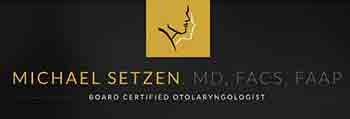ACCLARENT AERA™ Eustachian Tube Balloon Dilation System in Nassau County & Long Island, NY
What is Eustachian tube dysfunction (ETD)?

Narrowing of the Eustachian tube causes patients to experience ear pain, pressure, fullness, popping, ringing, or muffled sounds in the affected ear(s).
The Eustachian tube is a narrow tube which links the back of the nose to the middle ear. It is normally closed but opens when we swallow, yawn or chew. It has three main functions:
- To protect the middle ear from sources of disease
- to ventilate the middle ear
- Help drain secretions away from the middle ear.1
Eustachian tube dysfunction (ETD) is the inability of the Eustachian tube to adequately perform these functions and failure of the valve of the Eustachian tube to open and/or close properly 2 ETD (Eustachian tube dysfunction) is estimated to affect up to 5% of the adult population.3
What are the Symptoms and Causes of Eustachian tube dysfunction?
Normally, the Eustachian tubes are working properly so you don’t notice them at all. Anything that prevents the tube from the opening can cause Eustachian tube dysfunction.
Eustachian tube dysfunction may occur when the mucosal lining of the tube is swollen, or does not open or close properly. It can occur after the start of a cold and other nose, sinus, ear and throat infections. 1
When they are not working properly, the patient can possibly feel the following symptoms: muffled hearing, the fullness of the ear, pain in the ear, inability to equilibrate middle ear (ME) pressure, tinnitus, and dizziness.4
ETD (Eustachian tube dysfunction) is estimated to affect up to 5% of the adult population.
What Happens if Eustachian tube dysfunction is Left Untreated?
Persistent Eustachian Tube Dysfunction can be associated with several serious conditions.
- Long-term ETD has been associated with damage to the middle ear and the eardrum. 1
- Otitis media with effusion, atelectasis of the ME, adhesive otitis, perforation of eardrum and Cholestetoma.4
Narrowing of the Eustachian tube causes patients to experience ear pain, pressure, fullness, popping, ringing, or muffled sounds in the affected ear(s).
Eustachian tube dysfunction treatment options:
Otolaryngologist Michael Setzen uses the ACCLARENT AERA™ Eustachian Tube Balloon Dilation System, the first device in the US indicated to dilate the Eustachian tube. The ACCLARENT AERATM system uses a small balloon to treat persistent Eustachian tube dysfunction (ETD), a condition in which pressure, pain or clogged or muffled sensations occur in the ear.
With the ACCLARENT AERATM system, a E.N.T. specialist Michael Setzen will use a catheter to insert a small balloon through the patient’s nose and into the Eustachian tube. Once inflated, the balloon opens up a pathway for mucus and air to flow through the Eustachian tube, which may help restore proper function. After the Eustachian tube is dilated, a doctor deflates and removes the balloon.
Happy Patient After Eustachian Tube Balloon Dilation

The ACCLARENT AERA™ Balloon is inflated to dilate the Eustachian Tube to relieve the symptoms of ETD.
Clinical Support
-
- Results from clinical studies demonstrated a 99.7 percent technical success rate in Eustachian tubes dilated.
- Studies also found a greater rate of tympanogram normalization than control subjects treated with medical management alone (51.8 vs. 13.9 percent), as well as a greater improvement in the quality of life measures.
- 56.1% vs. 8.5% improvement in the Quality of Life measure from the Eustachian Tube Dysfunction Questionnaire (ETDQ-7).
- Additionally, there were zero reported serious device- or procedure-related adverse events. 5
Caution: Federal (U.S.) law restricts the sale, distribution or use of the ACCLARENT AERA™ by or on the order of a physician who is trained in the use of Acclarent technology.
Eustachian tube balloon dilation has associated risks, including tissue and mucosal trauma, infection, or possible carotid artery injury. Prior to use, it is important to read the Instructions for Use and to understand the contraindications, warnings, and precautions associated with these devices. Consult your physician for a full discussion of risks and benefits to determine whether this procedure is right for you.
ACCLARENT AERA Procedure Video
1 Llewellyn, A., Norman, G., Harden, M., Coatesworth, A., Kimberling, D., Schilder, A. and McDaid, C. (2014). Interventions for adult Eustachian tube dysfunction: a systematic review. HEALTH TECHNOLOGY ASSESSMENT, 18; 1-180.
2 Grimmer, J.F., & Poe, D.S. Update on Eustachian Tube Dysfunction and the Patulous Eustachian Tube. Curr Opin Otolaryngol Head and Heck Surg, 13: 277-282.
3 Ockermann, T., Reineke, U., Upile, T., Ebmeyer, F., Sudhoff, H.H. (2010). Balloon Dilatation Eustachian Tuboplasty: A Clinical Study. Laryngoscope, 120:1411–1416.
4 Randrup, T.S. & Ovesen, T. (2015) Balloon Eustachian Tuboplasty: A Systematic Review. Otolaryngology-Head and Neck Surgery, 152(3); 383–392.
5 ACCLARENT AERA™ Eustachian Tube Balloon Dilation System Instructions for Use. Irvine, CA: Acclarent, Inc; 2016. IFU005146 Rev D
ACCLARENT AERA™ Eustachian Tube Balloon Dilation System FACT SHEET
061233-161006 © Acclarent, Inc. 2016. All rights reserved.
Schedule Your Consultation Today!
Interested in learning more about our procedures? Give Dr. Setzen a call at 516-829-0045 to schedule your consultation today! Our practice serves Great Neck, NY & all nearby areas.




